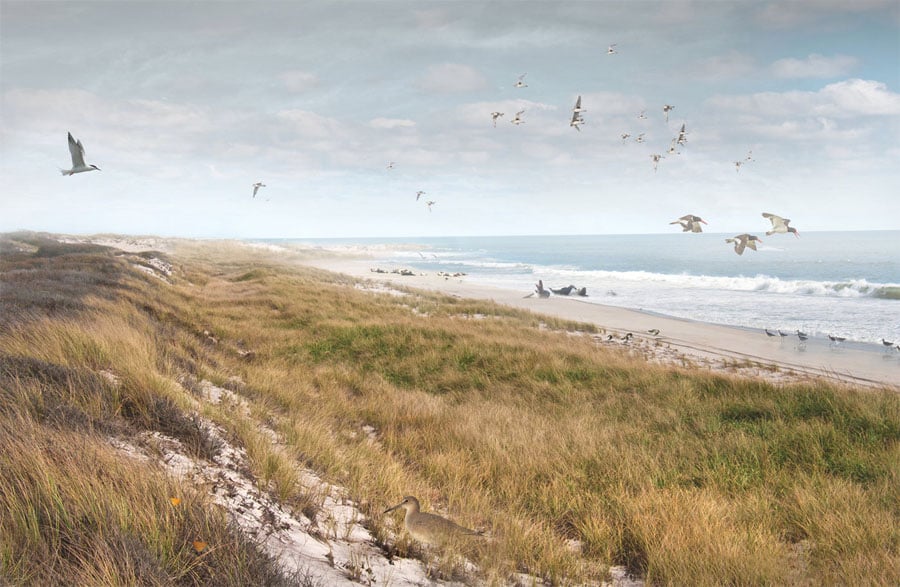
September 19, 2017
The Bold Plan to Help Save the Mid-Atlantic Coast from Storm Surges
Metropolis talked to Harvard GSD Professor Jesse M. Keenan on “Blue Dunes: Climate Change By Design,” a book he co-edited with Claire Weisz of WXY Architecture.
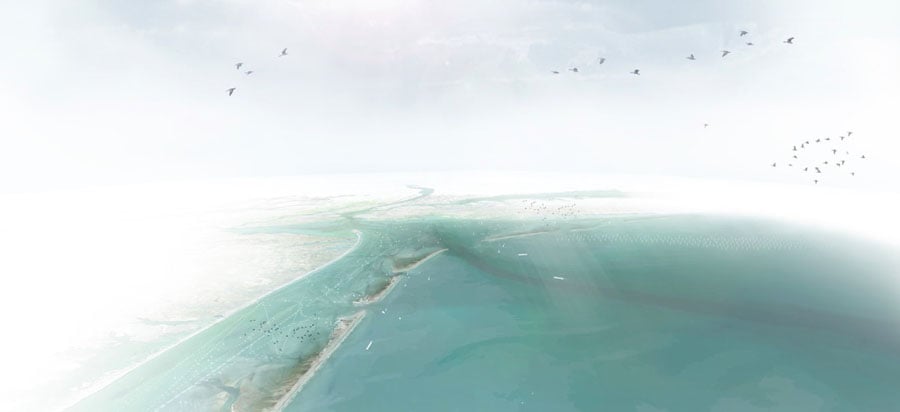
Resiliency seems to be on the tips of everyone’s tongues, from architects and planners to city officials. Hurricanes Harvey and Irma demonstrated how vulnerable global coastal cities really are to sea level rise, coastal storms, and flooding. Greater attention must be placed on enhancing the adaptive capacity of built environments around the world.
Addressing these issues requires thinking across neighborhood, metropolitan, and regional scales. This framework is inherently interdisciplinary and will breed solutions that are entangled in governmental and ecological processes. That is not to discount the architectural dimension, which can play a powerful role in communicating these proposals to the public. Blue Dunes, a project by Claire Weisz of WXY Architecture and West 8, combines all these aspects into a plan that would build artificial barrier islands along the Mid-Atlantic coast of the United States. The project is documented in Blue Dunes: Climate Change By Design, which was published by Columbia Books on Architecture and the City in April. Weisz co-edited the volume with Jesse M. Keenan, a professor at the Harvard University Graduate School of Design (GSD), where he teaches and researches topics related to urban development and climate change.
Metropolis contributor Akiva Blander recently spoke with Keenan about the project and its development, the relationship between climate adaptation and resilience, and the future of climate science in light of our current political situation.
Akiva Blander: Let’s start by talking a little bit about the plan itself. From a technical point of view, how would the construction of barrier islands mitigate the risks associated with climate change, namely coastal flooding and storm surges?
Jesse Keenan: In this case, the construction of these dunes at a regional scale would mitigate one particular type of risk under a particular type of scenario—inundation from storm surge from coastal storm events. It’s not a be-all, end-all. It certainly doesn’t solve, or attempt to solve, the broad spectrum of issues relating to sea level rise and coastal inundation. But, what it does is buy some time from those intervening storms that we know have a probability of occurring in a much greater probability than we care to fully recognize. Blue Dunes allows us to buy ourselves some time as we either adapt or build some measure of resiliency in various places along the coast.
AB: In the book, you speak a lot about this coalition building—merging all these interests and uniting all these stakeholders and actors—and you really emphasize the interdisciplinary nature of tackling the problem. Is the main contribution of Blue Dunes a certain built design, or is its goal more to advance a framework that involves all these disparate interests?
JK: That’s a very acute question that speaks to the heart of why we attempted to accomplish with the book. The designs have a certain ethereal, sort of atmospheric condition to them. You have landscape. You have ecology. You have all of these various aspects. The places themselves, I think, have a certain aesthetic. They have a certain value, both discursively, rhetorically, and also practically, but what the book really memorializes, and I think is of value to readers, is that it’s a methodology. It’s essentially acknowledging the conflicts inherent to when you bring engineers and designers, scientists and urban planners, risk modelers and financial analysts together, where they come at it with different levels of risk and different thresholds of proprietary decision-making. Asking, for example, is it a community decision? Is it an ecological framing? Is it based on science or public policy or judgment? All of these decisions that need to be made in the design process and in the workflow are emulated and abstracted in the book, so that you get a sense that there is a way forward. There are challenges ahead that define all of this, but with some measure of careful planning and management, there are a lot of methodologies that translate to not only inspiring design but also informing and calibrating that design.
The designs will stand for themselves. There’s a lot of pretty pictures that we can all admire. There’s a certain ambition to achieve a high level of design, but it’s more fundamentally about the methodology.
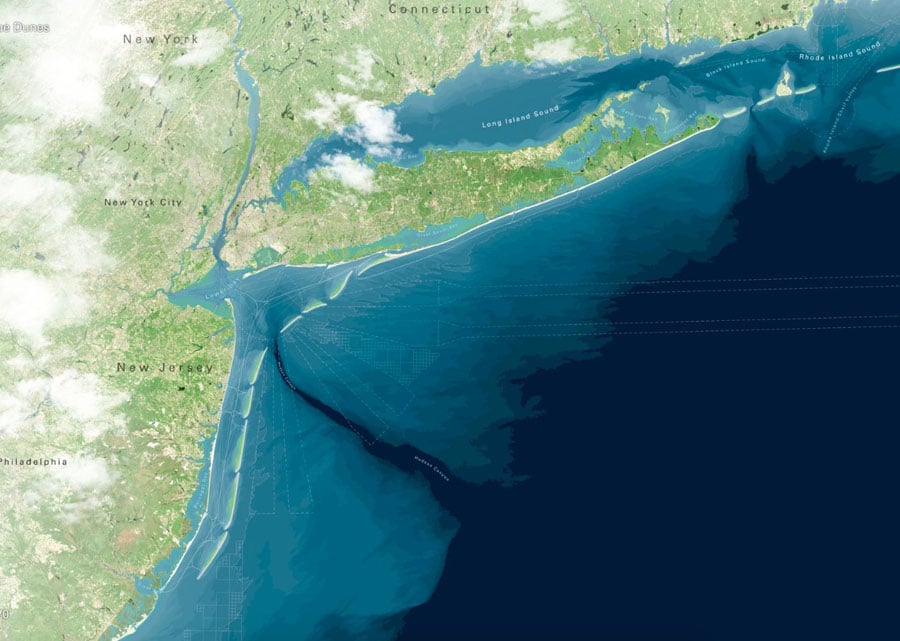
AB: Going off that point, how realistic from both a political will and an engineering perspective do you think this project is? Do you see any possibility that it’s ever going to be sitting eight miles out from New York City in the Atlantic?
JK: The same way that we mobilized a certain industry associated with the space program—and I know this is a metaphor that’s often used and misused—but we have to think at the scale of the challenge that we have [before us]. Just in terms of the material response, not even the social or behavioral response, we have to mobilize a new industrial sector to fully engage this. From an engineering point of view, it’s totally feasible, and it’s feasible in terms of cost and any number of aspects relating to production.
But, as we highlight in the book, there’s a number of challenges, for instance, relating to a dredge fleet, certain types of environmental regulation for testing the sediment and making sure they’re partially mitigating certain environmental impacts. Can we fully mitigate the impacts? No. That is a highly contentious aspect of the work. In terms of process and due process, it’s a feasible project. In terms of political will relative to the cost and who bears that cost, it’s less feasible. But, my interpretation from the very beginning was that this was more about challenging the conventions of looking at a particular project in a particular place, because if we focus our energies on a block or district, we’re missing the point that this is a regional, national, and global problem, right?
Unless we’re fully engaging design across a spectrum of scales, and at least in a regional scale, we would be missing an opportunity to fully engage design, because you know what? We’re already doing things, like in transportation planning and investment in infrastructure, that shape a regional footprint. How can we mainstream climate adaptation into existing parameters at a regional level or at a metropolitan level that has a broader scale or effect? Because at the end of the day, we have to economize the limited resources that we have. Very often, working at a bigger scale brings you that economy of scale. For instance, a focus on building codes is often misplaced because it is more fundamentally about land use planning.
AB: In the book, you often talk about the synergies and conflicts between resilience and adaptation. What does that mean for the rest of us?
There are different categorical variants for resilience. There’s disaster resilience. There’s engineering resilience. There’s ecological resilience. There’s socio-ecological resilience. There’s urban resilience. They all mean slightly different things, but they primarily reflect this idea of a single equilibrium, which is that there’s something inherent in the processes of resilience where one reverts to the relative status quo. That’s a relative proposition. So, you can build back better, but you’re still building the same thing in the same place with likely the same or similar methods and materials.
Adaptation, though, is more fundamentally about the incremental, transitional, and transformational definitions of system processes that transform us and bring us to a wholly different domain of operation. In the built environment, this means that we have to build in different places, with different densities, different infrastructure, and different communities. We have to transform our way of life. Perpetuating ways of life only through certain types of resilience will never address our underlying vulnerabilities.
When we try to focus on localism and community resilience solely, what we’re doing is driving deeper and deeper entrenchment of the status quo. That serves the interests of the status quo. Politicians and foundations love that because that speaks to their constituency, but over the long term, we run the risk that much of this type of resilience is actually setting us up for maladaptation. For example, we can elevate houses in New York as an act of resilience, but that doesn’t make any economic sense for any number of reasons. As an economic asset, it may even be accelerating the depreciation of the asset. With sea level rise, it’ll all be gone within 20 or 30 years anyway.
The point is that we have to be critical about the language we use in the underlying analysis and design and legislative intent, and if we don’t fully recognize both the synergies and the conflicts between resilience and adaptation, we will be doing ourselves a tremendous disservice. That isn’t to say that there aren’t any aspects of resilience that are extraordinarily valuable, but it does mean to say that we need to be disciplined in how we apply tactics and strategies of resilience. This book thinks about how you apply these categories of resilience and transformational adaptation, both in biophysical processes and socioeconomic processes, and how we resolve these synergies and conflicts to have a more clarified design and legislative intent.
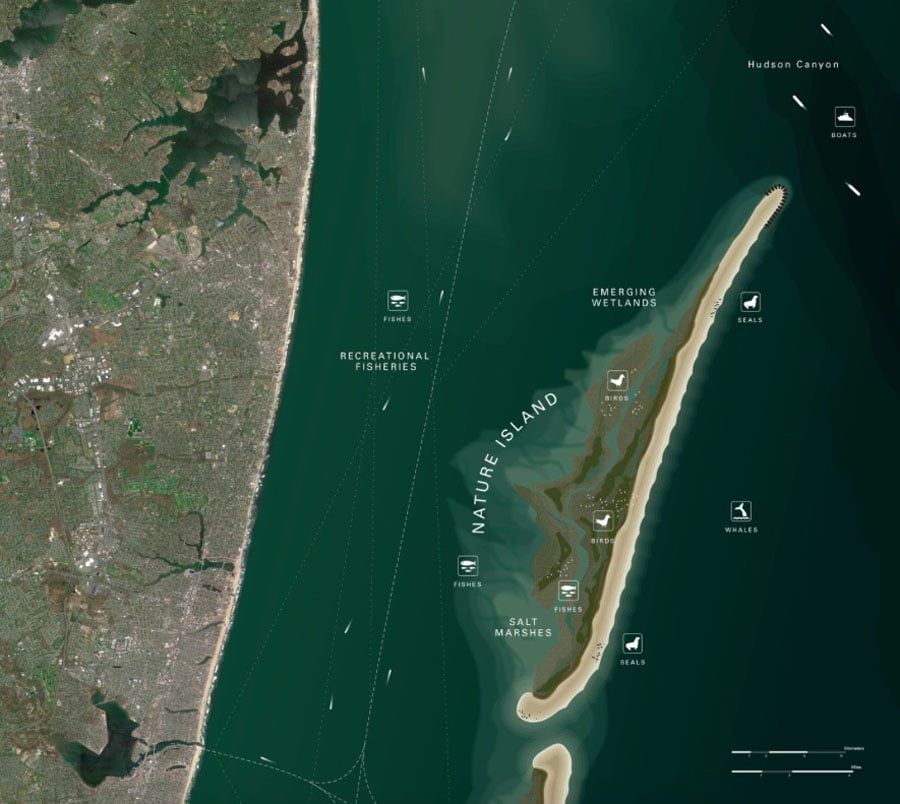
AB: I thought the maladaptation point is really interesting—how adaptation or resilience for one can mean the opposite for another. What are some of the potential misreadings of the Blue Dunes proposal?
JK: With maladaptation, as we focus on adaptation and resilience analytically, we always have to keep in mind that there’s this proposition that what may be adaptive at one scale may be maladaptive in another scale. Blue Dunes is a good example where at a regional scale, this may actually be adaptive, but at a local ecological scale it may be maladaptive.
In a regional scale, Blue Dunes may be adaptive in terms of human settlement, but it could be maladaptive in terms of fisheries migration, in terms of disrupting dependent ecological systems or a certain type of flora or fauna. That may even be another level of maladaptation to people, because even though we are preventing or mitigating some level of inundation from storms, people may look at that type of adaptation and become over-reliant on it and, in response, build more risky real estate on the coast, similar to what happened in New Orleans. People saw that you had a levee system and said, “Oh, well, we’re fine. We can build right up to the edge.” Something that may be potentially adaptive may, in behavioral terms, lead to a type of maladaptation. Certainly, there are any number of aspects of Blue Dunes that may, both ecologically and socioeconomically, lead to a type of maladaptation.
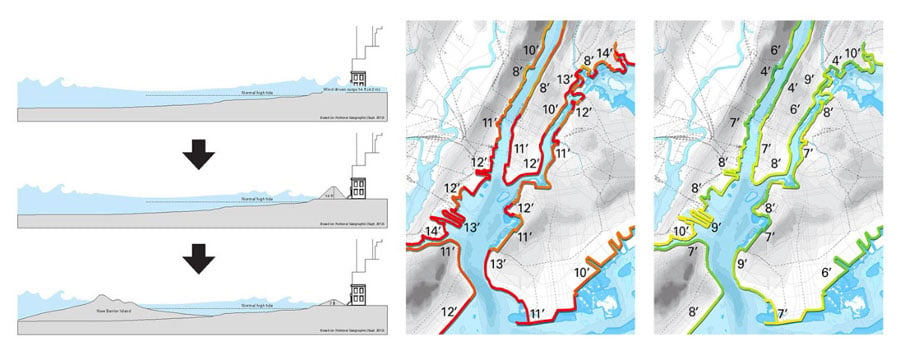
AB: What do you think are the main obstacles to implementing Blue Dunes, or something like it, especially in light of our current administration?
JK: One would be that it would require multiple jurisdictions and private sector entities to have some negotiated commitment from the insurance industry that the reduction in risk would result in a reduction in premiums or deductibles. Thereafter, you would have to provide financing that takes the money that you would have otherwise spent on increased premiums, and have some percentage of that go to finance the bonds to support the construction and operations and maintenance of Blue Dunes. That requires a political and economic negotiation between public and private actors with the insurance and the reinsurance industry.
I think increasingly in the United States, particularly with flood insurance reform on the table, the federal government can’t continue to foot the bill, no matter which way you look at it. With pending rulemaking now relating to the public assistance deductible, we’ll see which way it goes. Eventually, the federal government is going to have to push more and more risk on state governments [and] that is going to require them to manage that risk, to bear some of that risk, and to mitigate some of that risk as it relates to promoting some measure of resiliency.
Even though there’s a current administration that is willfully ignorant and entirely biased to disregard science in their own self-interest, which runs in defiance of the notion of truth by which this country was founded, a certain absolutism of truth, that there is agreement among ideologues and empiricists—and even conservative Republicans, whoever they are—that the states will ultimately have to take more responsibility. That means local governments will have to take responsibility. That means that the challenges here are not about projects, but they’re really more fundamentally about land use. Until local governments take and bear the burden of more responsible land use planning, there’s not much that we can do.
You may also enjoy “What If…We Could Save Our Coastal Cities by Treating Land Like Water?“
Recent Viewpoints
Viewpoints
Google’s Ivy Ross Makes Sense of Color





